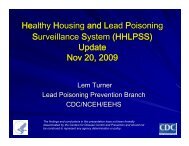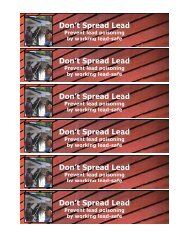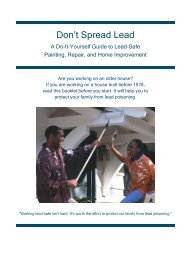brochure describing the booklet. - New England Lead Coordinating ...
brochure describing the booklet. - New England Lead Coordinating ...
brochure describing the booklet. - New England Lead Coordinating ...
Create successful ePaper yourself
Turn your PDF publications into a flip-book with our unique Google optimized e-Paper software.
If you are doing major repairs or<br />
renovations that may create a lot of<br />
dust—jobs like replacing<br />
windows—consider taking a<br />
training course in lead-safe work<br />
practices. Or consider hiring a<br />
qualified contractor who has been<br />
trained in lead-safe practices.<br />
For more information about working<br />
lead-safe, contact your state’s<br />
public health agency or <strong>the</strong> o<strong>the</strong>r<br />
agencies listed below.<br />
U.S.<br />
Environmental<br />
Protection<br />
Agency<br />
U.S.<br />
Department of<br />
Housing and<br />
Urban<br />
Development<br />
www.epa.gov/ne/eco/ne_lead<br />
www.hud.gov/offices/lead<br />
Don’t Spread <strong>Lead</strong> has been written for<br />
do-it-yourselfers. It is not intended for paid<br />
contractors, renovators, maintenance<br />
workers, painters, and o<strong>the</strong>r tradespeople.<br />
Paid contractors who are renovating,<br />
repairing, or painting homes, child-care<br />
facilities, and many schools that were built<br />
before 1978 must comply with a new rule<br />
issued by <strong>the</strong> U.S. Environmental<br />
Protection Agency. The Renovation,<br />
Repair and Painting Rule of 2008 requires<br />
<strong>the</strong>se contractors to use specific lead-safe<br />
work practices. The practices are similar to<br />
<strong>the</strong> ones described in this <strong>booklet</strong> for do-ityourselfers<br />
but have more detailed<br />
requirements.<br />
If you are hiring a contractor, make sure<br />
that <strong>the</strong> contractor knows about this EPA<br />
rule and will follow its requirements.<br />
For more information about <strong>the</strong> rule, see<br />
http://www.epa.gov/lead/pubs/renovation.htm.<br />
Don’t Spread<br />
<strong>Lead</strong><br />
A Do-It-Yourself Guide<br />
to <strong>Lead</strong>-Safe<br />
Painting, Repair, and<br />
Home Improvement<br />
U.S. Centers<br />
for Disease<br />
Control and<br />
Prevention<br />
<strong>New</strong> <strong>England</strong><br />
<strong>Lead</strong><br />
<strong>Coordinating</strong><br />
Committee<br />
www.cdc.gov/nceh.lead/lead.htm<br />
www.nelcc.uconn.edu<br />
Are you working on an older<br />
house?<br />
For a CD showing how to work leadsafe,<br />
contact <strong>the</strong> Connecticut<br />
Department of Public Health at 860-<br />
509-7299, or see <strong>the</strong> online version at<br />
http://douglassarpy.unl.edu/eh/lead_video.shtml.<br />
This program is available in English<br />
and Spanish.<br />
The Don’t Spread <strong>Lead</strong> <strong>booklet</strong> was developed<br />
by <strong>the</strong> <strong>New</strong> <strong>England</strong> <strong>Lead</strong> <strong>Coordinating</strong><br />
Committee<br />
www.nelcc.uconn.edu<br />
NELCC is administered by <strong>the</strong><br />
Healthy Environments for Children Initiative<br />
at <strong>the</strong> University of Connecticut<br />
2008<br />
If you are working on a house<br />
built before 1978, learn how to<br />
protect yourself, your family,<br />
and your neighbors from lead<br />
poisoning.
Maybe you are painting a room<br />
for a new baby.<br />
Or maybe you are repairing a<br />
door that sticks.<br />
These and similar small projects<br />
can be great do-it-yourself jobs. But<br />
if you are working in a house that<br />
was built before 1978, it may<br />
contain lead paint.<br />
Common fix-up jobs (such as<br />
painting a room or repairing a door<br />
that sticks) can create dust or paint<br />
chips that contain lead.<br />
<strong>Lead</strong> is a poison that is dangerous<br />
to you, your family, and your<br />
neighbors.<br />
Why should you work lead-safe?<br />
When people swallow or brea<strong>the</strong> in<br />
lead dust, <strong>the</strong>y can become lead<br />
poisoned. It takes only a very small<br />
amount of lead to poison someone.<br />
<strong>Lead</strong> is especially dangerous for<br />
children. It can harm <strong>the</strong>ir brains<br />
and cause serious learning and<br />
behavior problems. It is very<br />
dangerous for pregnant women<br />
and <strong>the</strong>ir unborn babies.<br />
<strong>Lead</strong> can also make adults sick.<br />
How can you work lead-safe?<br />
You can learn how to protect<br />
yourself when you work around<br />
lead paint.<br />
The following list outlines five<br />
important steps to work lead-safe.<br />
To learn more about <strong>the</strong>se five<br />
steps, download <strong>the</strong> <strong>booklet</strong><br />
Don’t Spread <strong>Lead</strong> from<br />
www.nelcc.uconn.edu/documents/DSL.pdf<br />
<strong>Lead</strong>-safety summary<br />
1. Protect your family and your<br />
neighbors.<br />
• Keep your family and<br />
neighbors out of <strong>the</strong> work area.<br />
2. Prepare your work area.<br />
• Empty <strong>the</strong> room.<br />
• Close it off from <strong>the</strong> rest of <strong>the</strong><br />
house.<br />
• Bring in your supplies.<br />
3. Protect yourself from lead dust.<br />
• Put on safety equipment, such<br />
as safety glasses and<br />
disposable coverings.<br />
• Do not eat, drink, or smoke in<br />
<strong>the</strong> work area.<br />
4. Work wet.<br />
• Lightly mist painted surfaces<br />
except near electrical outlets.<br />
• Scrape or sand by hand, not<br />
with power tools.<br />
5. Work clean.<br />
• Keep dust inside <strong>the</strong> work<br />
area.<br />
• Clean often, using damp rags<br />
or paper towels.<br />
• Use a HEPA vacuum cleaner,<br />
a special vacuum cleaner that<br />
traps tiny bits of lead dust.<br />
• Wash and rinse.<br />
• Dispose of trash safely.<br />
• Check your work.<br />
The list above is just an outline.<br />
Learn more before you start repairs<br />
or renovations.






